Road Signs and Their Meanings
Traffic signs are one of the three major methods of controlling traffic flow. In combination with signals and pavement markings, they help to provide for the orderly movement of traffic.
With so many vehicles on the roads, we need to be directed. Can you imagine the chaos if we all drove without signs and signals telling us what to do?
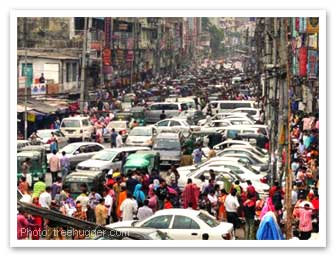 Traffic Chaos
Traffic Chaos
Road signs have specific colors and shapes associated with their meaning. This combination of colors and shapes is designed to allow drivers to see and recognize what the sign means from a distance.
Pay close attention to signs as you drive. There are four basic categories of signs:
- Regulatory: These communicate what you should do and control traffic flow.
- Warning: These communicate roadway situations and hazards.
- Guide: These provide information and direction.
- Driver Services and Recreation Signs: These provide drivers with information about nearby amenities, parks, and recreational areas.
Regulatory signs are there to tell drivers what to do. They regulate such things as speed, passing, and lane use. Regulatory signs must be obeyed in the same way as traffic laws.
A common example of a regulatory sign is a “Stop” sign because it regulates your behavior on the road and tells you what to do: stop.
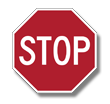 Regulatory Sign
Regulatory Sign
Warning signs alert you to important conditions on the road ahead. These may be road hazards, changes in direction, or some other situation you need to know about. Many of the yellow diamond shaped signs let you know that you should slow down, especially on wet roads. Warning signs are there for your benefit, and they must be observed. To disregard one may be a traffic violation and could put you or others in a dangerous situation.
A common example of a warning sign is a pedestrian crossing sign. It warns you of an area where pedestrians cross the roadway so you can be alert and prepare to slow down and stop.
 Warning Sign
Warning Sign
Guide signs vary widely and usually provide some interest to your travels. They are especially helpful when you are traveling somewhere outside your home area. Guide signs often furnish travel information, route markers and other pieces of interesting information.
An example of a guide sign is a highway sign, because it shows you what road you’re driving on and which lane to stay in to continue on that route.
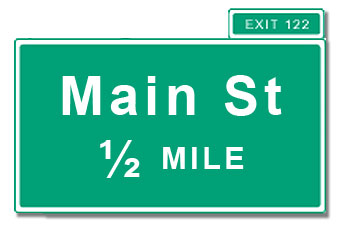 Guide Sign
Guide Sign
Driver services and recreation signs let roadway users know if nearby amenities and services are available. These signs will often indicate how far away service is from the driver's current position on the road.
An example of a driver services and recreation sign is a fuel services available sign, because it alerts drivers to nearby amenities.
 Service Sign
Service Sign
It's important for drivers to be able to identify signs and their meanings.
Traffic Sign Colors and Their Meanings
Below are the standard colors you’ll encounter on traffic signs and their general meanings.
 Standard Colors
Standard Colors
- Red: Stop or prohibition
- Green: Indicates movement permitted, direction guidance
- Blue: Driver services guidance
- Yellow: General warnings
- Black: Regulation
- White: White
- Orange: Construction and maintenance warning
- Brown: Public Recreation and scenic guidance
Red, Black on White, or Red on White
Red signs tell you to stop or yield the right-of-way. They may also prohibit certain actions.
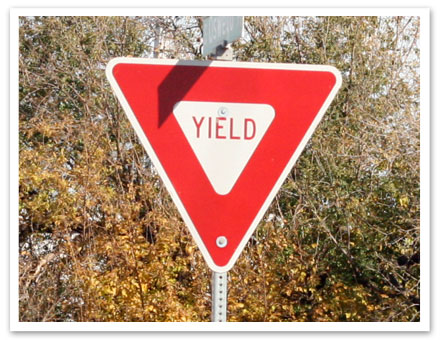 Service Sign
Service Sign
Green
Guide signs are green. They indicate that a certain movement is permitted and give guidance to certain destinations, such as highway entrances and exits or distance to upcoming destinations.
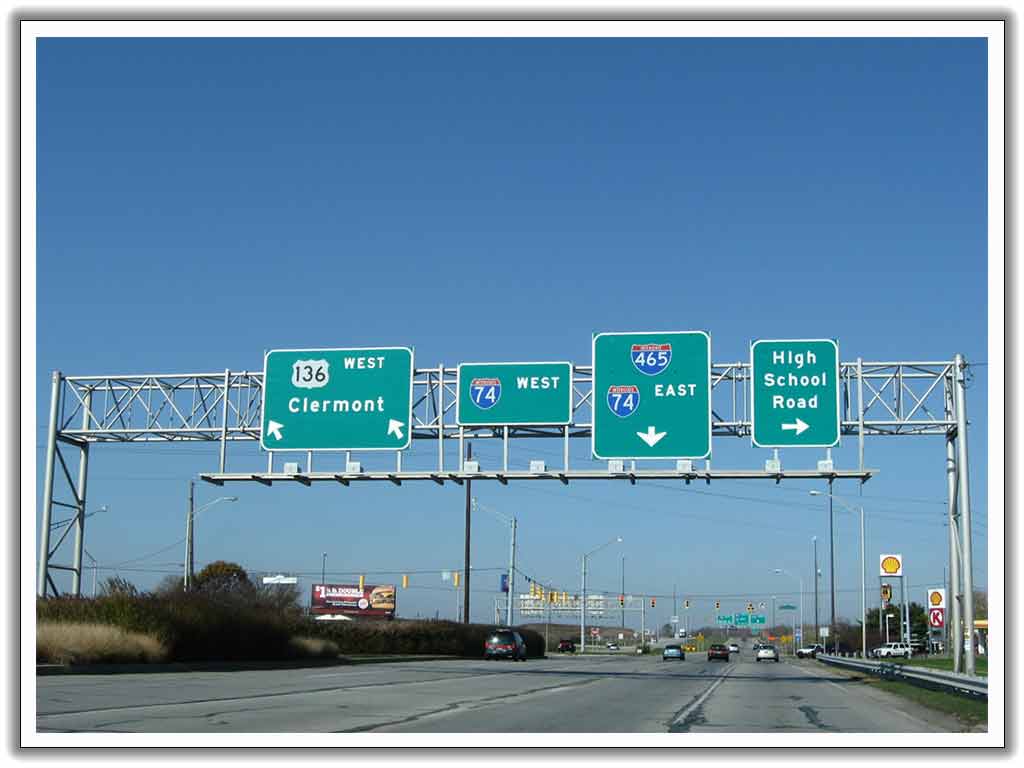 Guide Signs in Indiana
Guide Signs in Indiana
Orange
Construction signs are orange. They warn you of construction and maintenance zones.
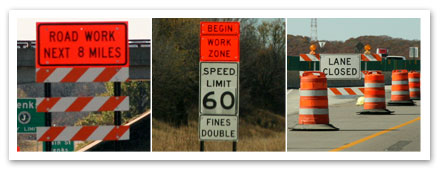 Construction Signs
Construction Signs
Blue
Service signs are blue. They direct you to driver services, such as rest areas on the highway.
 Rest Area Sign
Rest Area Sign
Brown
Recreational signs are brown. They indicate public recreation and cultural interest areas.
Traffic Sign Shapes and Their Meanings
Traffic signs have different shapes so you can know what to do even at a distance. If you see an octagonal sign from far away, but you can’t read the words, you’ll still know to stop—especially when the sign is red! By memorizing these shapes and colors, you can teach yourself to instinctively respond to their commands. When you take your knowledge exam, you’ll have to identify signs by just their color and shape.
 Traffic Sign Shapes
Traffic Sign Shapes
Here's a breakdown of what each shape means. We'll discuss them in more detail afterwards.
- Octagon: Exclusively for stop signs
- Horizontal Rectangle: Generally for guide signs
- Equilateral Triangle: Exclusively for yield signs
- Pennant: Advance warning of a no passing zone
- Diamond: Exclusively used to warn of existing or possible hazards on the roadway or adjacent areas
- Vertical Rectangle: Generally for regulatory signs
- Circle: Railroad advance warning signs
Octagon
This shape is used exclusively for stop signs. You immediately should be able to recognize that an octagon-shaped sign means stop. Always come to a complete stop before the pedestrian crosswalk, even when it isn’t marked. Stay stopped until the way is clear in all directions.
Sometimes you will see a rectangular sign below a stop sign. These usually signify a four-way or all-way stop, meaning all traffic approaching the intersection must stop.
Equilateral Triangle, Point Down
This sign is used exclusively for yield signs. You should be able to recognize immediately that any sign this shape with the point facing down means yield to other vehicles and pedestrians. Slow down and prepare to stop when you see this sign. Let oncoming vehicles pass before crossing the road ahead or entering the flow of traffic. It is important to pay close attention to the road and side of the road when you see these signs, because they tell you that other vehicles or pedestrians are close or approaching and may merge with your path of travel.
Circle
This shape is used only to warn of railroad crossings. You should be able to recognize immediately that a sign in the shape of a circle means there’s a railroad crossing ahead.
Crossbuck
This sign looks like an X and is used to warn of a railroad crossing. When you come upon this sign, you should be able to recognize immediately that the shape of a crossbuck means there’s a railroad crossing ahead.
Pennant
A pennant is used exclusively to indicate a no passing zone. A no passing zone means that you may not pass other vehicles in a certain section of roadway, because you won’t be able to see far enough ahead to pass safely.
Pentagon
Pentagons are used exclusively to indicate a school zone or a school crossing. When you see this sign, remember that children are likely present, so you’ll need to be extra careful to watch out for children in or around the roadway. Often, these signs are accompanied by a school speed limit sign. These are a vertical rectangle, sometimes with a traffic light at the top.
Diamond
Diamond-shaped signs are used exclusively for warning signs, which we will cover extensively in one of the next sections. Examples of warning signs are: crossroad ahead, end/begin divided road, merging traffic, curves, and construction warning signs. When you see these signs, you should be able to recognize immediately that a sign in the shape of a diamond indicates that there is either a potentially dangerous situation ahead or some change in roadway condition.
Vertical Rectangle
The vertical rectangle is used for regulatory signs, such as speed limit, no parking, carpool, and keep right. It’s also sometimes used for warning signs, such as slow, children at play. You should be able to recognize immediately that a sign in the shape of a vertical rectangle indicates a regulatory or warning action you must obey.
Square
Squares are used to denote regulatory, warning, and guide signs. Examples of regulatory signs are do not enter, no U turn, no parking, and no pedestrian crossing. Warning signs are signs such as advisory speed limits and construction. Guide signs indicate areas such as camping and airports.
Horizontal Rectangle
The horizontal rectangle is used for regulatory signs such as road closed and carpool. It also is used for warning signs such as signal or stop ahead, and guide signs such as rest area ahead and construction.
Trapezoid
The trapezoid is used for recreational area guide signs in some states. These are signs that indicate rest areas and tourist information ahead.
Take a look at the image below. Try to memorize the shapes and colors of road signs so that you're prepared for anything out on the road!
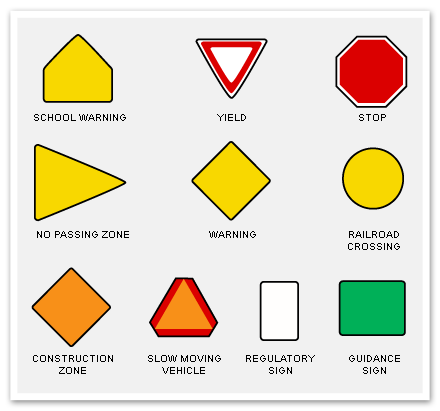 Traffic Signs
Traffic Signs
Take a Course to Learn More
If you enjoyed this article and are interested in learning more about driving-related topics, you should check out our courses on www.safe2drive.com.
We offer courses in a variety of topics including Defensive Driving and Driver Education. In addition to teaching you how to be a safe driver, our courses can help you dismiss a ticket, get your driver license, or even get an insurance discount. We also have courses specifically tailored to mature drivers (i.e., drivers age 55 and older) for insurance discounts.